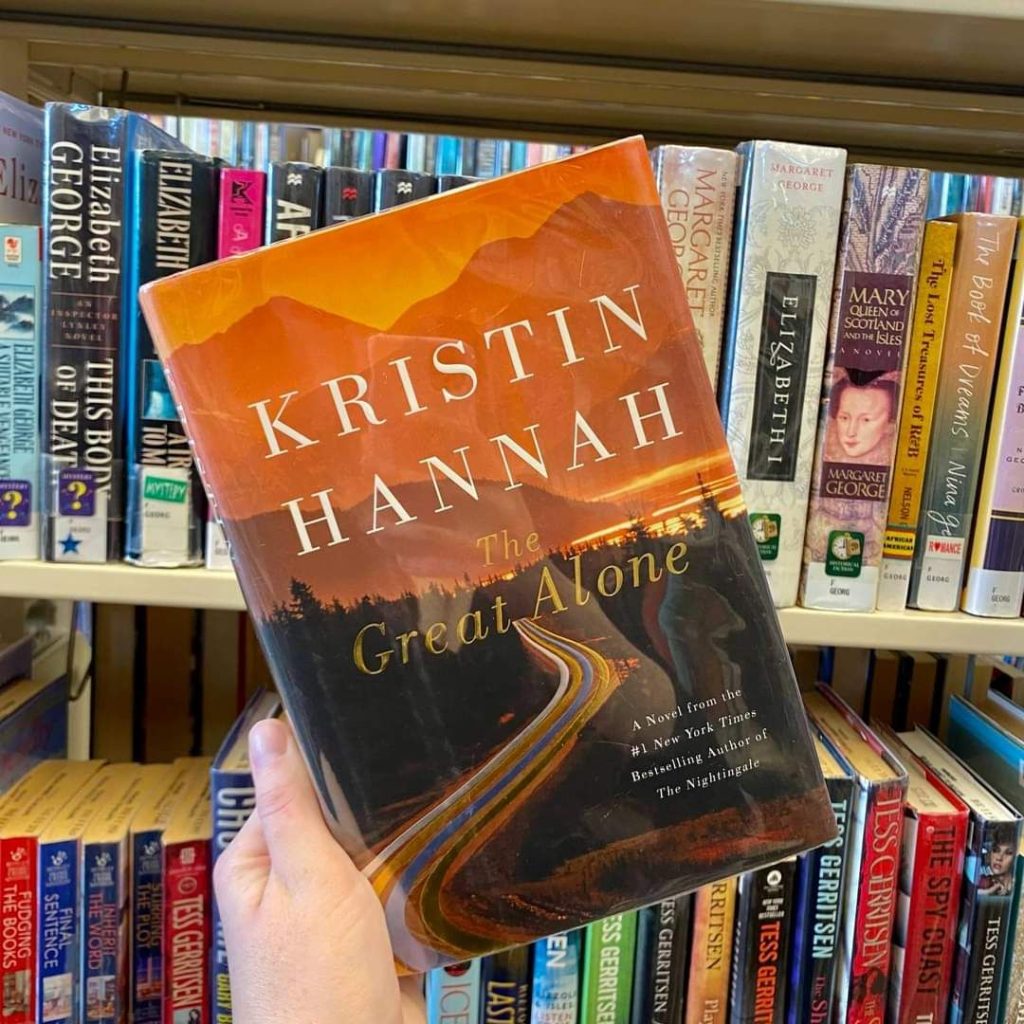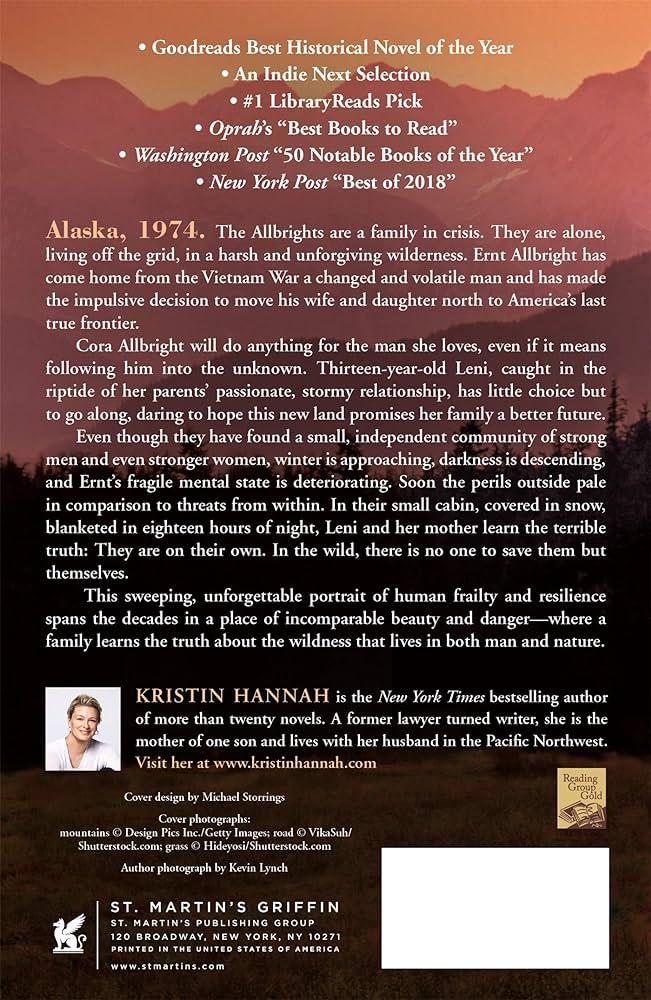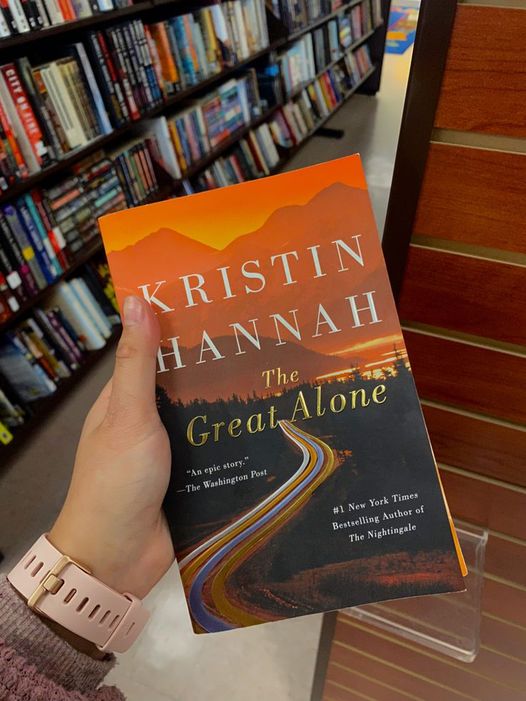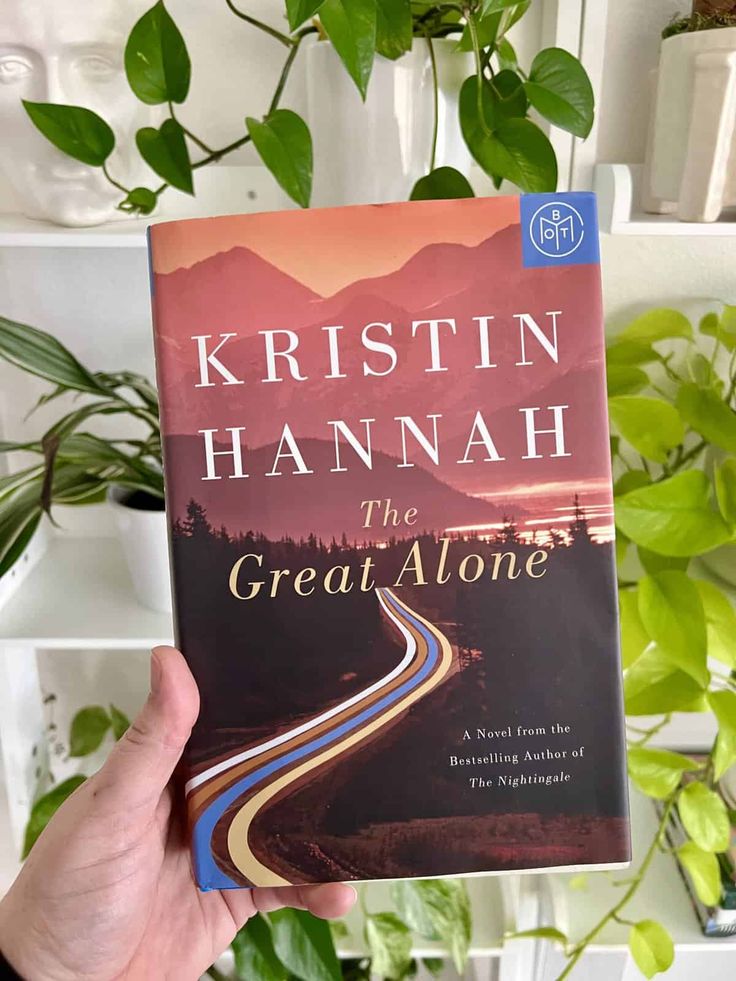The Great Alone at #1 on the New York Times bestseller list
The Great Alone by Kristin Hannah is a captivating and emotionally charged novel set in the 1970s. It follows the Allbright family, who move to the remote wilderness of Kaneq, Alaska, seeking a fresh start. The father, Ernt Allbright, is a Vietnam War veteran struggling with PTSD, and his unpredictable, violent behavior worsens as the isolation and long Alaskan winters take hold.
The story is told from the perspective of Leni, Ernt’s teenage daughter, who tries to navigate the challenges of growing up in a harsh, unforgiving environment. Her mother, Cora, is trapped in an abusive marriage, and as the family becomes more isolated, the tension and danger grow.
While the Alaskan landscape is stunning and unforgiving, survival becomes a central theme—not just surviving the wild, but also surviving Ernt’s escalating abuse. Leni forms a bond with Matthew, a boy from the local community, and their connection offers her a glimpse of hope and love amidst the darkness.
“Books are the mile markers of my life. Some people have family photos or home movies to record their past. I’ve got books. Characters. For as long as I can remember, books have been my safe place.”
― Kristin Hannah, The Great Alone

Brief Summary of The Great Alone by Kristin Hannah
Ernt Allbright, a former POW, comes home from the Vietnam war a changed and volatile man. When he loses yet another job, he makes an impulsive decision: he will move his family north, to Alaska, where they will live off the grid in America’s last true frontier.
Thirteen-year-old Leni, a girl coming of age in a tumultuous time, caught in the riptide of her parents’ passionate, stormy relationship, dares to hope that a new land will lead to a better future for her family. She is desperate for a place to belong. Her mother, Cora, will do anything and go anywhere for the man she loves, even if means following him into the unknown.
At first, Alaska seems to be the answer to their prayers. In a wild, remote corner of the state, they find a fiercely independent community of strong men and even stronger women. The long, sunlit days and the generosity of the locals make up for the Allbrights’ lack of preparation and dwindling resources.
But as winter approaches and darkness descends on Alaska, Ernt’s fragile mental state deteriorates and the family begins to fracture. Soon the perils outside pale in comparison to threats from within. In their small cabin, covered in snow, blanketed in eighteen hours of night, Leni and her mother learn the terrible truth: they are on their own. In the wild, there is no one to save them but themselves.

The Great Alone Summary of Key Lessons and Review
Kristin Hannah’s “The Great Alone” is a powerful exploration of resilience, survival, and the complexities of family. Would you like to delve deeper into a specific theme or character from the book?
Here are 10 lessons that can be gleaned from the book:
1. Wilderness reveals inner strength: Alaska’s harsh beauty and unforgiving environment push Leni and Cora Allbright to their limits. They discover hidden resilience, resourcefulness, and a fierce determination to survive, proving that sometimes the greatest challenges bring out our greatest strengths.
2. Love endures even in the harshest conditions: Ernt Allbright’s love for Cora and Leni is undeniable, but it’s a love warped by trauma and expressed through violence and control. This complex relationship highlights the enduring power of love, even when it manifests in unhealthy ways.
3. Facing the darkness within: The Alaskan wilderness serves as a mirror, reflecting the characters’ inner demons. Ernt confronts his PTSD and the darkness of his past, Leni grapples with teenage angst and the weight of family secrets, and Cora battles
her own vulnerabilities. Facing these internal shadows is crucial for personal growth.
4. Community offers solace and survival: Despite the isolation of their Alaskan homestead, the Allbrights find solace and support in the unlikely community that forms around them. This chosen family helps them navigate hardship, providing emotional and practical assistance, and reminding them that they are not alone.
5. Silence speaks volumes: Leni’s journey is marked by unspoken emotions and suppressed memories. The novel explores the power of silence as a form of protection, a coping mechanism, and a bridge to understanding. Learning to listen to and express the unspoken can be deeply healing.
6. Nature’s power inspires and humbles: Alaska’s raw beauty and unforgiving nature both inspire awe and demand respect. The characters learn to appreciate its delicate balance, understand their place within it, and recognize that they are not conquerors but participants in a grander ecosystem.
7. Choices define our paths: Every decision, from Ernt leaving Vietnam to Cora choosing to stay with him, shapes the Allbrights’ lives. The novel emphasizes the importance of taking responsibility for our choices and understanding how they set us on the path we walk.
8. Forgiveness can be a double-edged sword: Leni grapples with the question of forgiving her father for his abuse. The novel explores the complexity of forgiveness, acknowledging its potential for healing but also recognizing the right to hold onto anger and seek justice.
9. Hope flickers even in the darkest times: Despite the violence, isolation, and trauma, the Allbrights never lose sight of hope. They find solace in small joys, hold onto dreams of a better future, and remind us that the human spirit can endure and rebuild even in the face of immense adversity.
10. The legacy of trauma echoes across generations: Leni’s experiences not only shape her present but also influence her future choices and relationships. The novel highlights the lasting impact of trauma and the importance of intergenerational healing to break destructive cycles.
By reflecting on these lessons, readers can gain deeper insights into the human experience and find inspiration for their own journeys of growth and resilience.

Final Thoughts: The Great Alone by Kristin Hannah
The Great Alone explores themes of survival, resilience, trauma, and the complexities of love and family, all set against the backdrop of the rugged Alaskan frontier. It’s a gripping and haunting story of strength in the face of hardship.
Kristin Hannah’s novel provides a powerful and moving portrayal of life in Alaska, offering insights and reflections on the human condition. provides a powerful and moving portrayal of life in Alaska, offering insights and reflections on the human condition. The book’s principles are applied to various areas of life, such as relationships, personal growth, and environmentalism.
In this unforgettable portrait of human frailty and resilience, Kristin Hannah reveals the indomitable character of the modern American pioneer and the spirit of a vanishing Alaska—a place of incomparable beauty and danger. The Great Alone is a daring, beautiful, stay-up-all-night story about love and loss, the fight for survival, and the wildness in both man and nature.

Thanks for reading the post (The Great Alone by Kristin Hannah) and we’ll see you on the next one!
For More Blog Posts: Click Here
Affiliate Disclosure: As an Amazon Associate, I earn from qualifying purchases. This blog post may contain other affiliate links as well by which I earn commissions at no extra cost to you.

